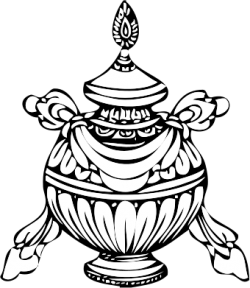The Treasure Vase
The vase (Skt. nidhana kumbha; Tib. gter gyi bum pa) is a fat-bellied vessel with a short, slim neck. On top, at the opening, there is a large jewel indicating that it is a treasure vase.
Its symbolic meaning was almost always associated with the ideas of storage and the satisfaction of material desires. In the sagas and fairy tales of many different cultures, for example, there is the recurring idea of an inexhaustible vessel.
The Vase of Inexhaustible Treasures is also known as “The Treasure Chest.” It symbolizes the spiritual abundance of the Buddha. No matter how much of Buddha's treasure he gave away, the amount of treasure in his chest never diminished. Despite the fact that Buddha's teachings have been dispersed to billions of people over the ages, his love and wisdom will never dimish.
In addition, the vase also represents longevity, wealth, prosperity and the manifestation of desires. The jewels that appear on the upper rim of the vase represent Buddha, dharma, and sangha.
Physically, the 'vase of inexhaustible treasures' is modeled on the traditional Indian clay water pot or kumbha with a flat base, round body, narrow neck and fluted upper rim.
However much is removed from it, this vase remains perpetually full.
Wealth vases, sealed with precious and sacred substances, are commonly placed upon altars and on mountain passes, or buried at water springs, where their presence is believed to attract wealth and bring harmony to the environment.
In relation to Buddhism it specifically means the spiritual abundance of the Buddha, a treasure that did not diminish, however much of it he gave away.
The question still remains of the association of these eight symbols with the Buddha's actual physical body. An ancient text called the Heap of Good Fortune Sutra (Aryamangalakutanama-mahayanasutra), while addressing the Buddha, has this to say on the issue:
Veneration to you with your head like a protecting parasol,
With eyes like the precious golden fishes (even today a woman with beautiful eyes is known as 'minakshi,' meaning one with fish-like eyes)
With neck like a precious, adorned vase of good fortune,
With speech like a right-turning Dharma shell,
With a mind infinite with wisdom like the never ending knot,
With a tongue open like the auspicious pink lotus,
With a body proclaiming triumph over the attacking armies of Mara,
With feet that tread the path of dharma like the auspicious wheel.
Artistically, these motifs may be depicted individually, in pairs, in fours, or as a composite group of eight. Designs of these eight symbols adorn all manner of sacred and secular Buddhist objects, such as carved wooden furniture, metalwork, wall panels, carpets and silk brocades.
They are also frequently drawn on the ground in sprinkled flour or colored powders to welcome visiting religious dignitaries. Indeed, no Tibetan ceremony, be it religious or secular (for e.g. a marriage), is complete without some depiction of the eight auspicious symbols of Buddhism, which are believed to propitiate the environment and grant protection to the activity being undertaken.
